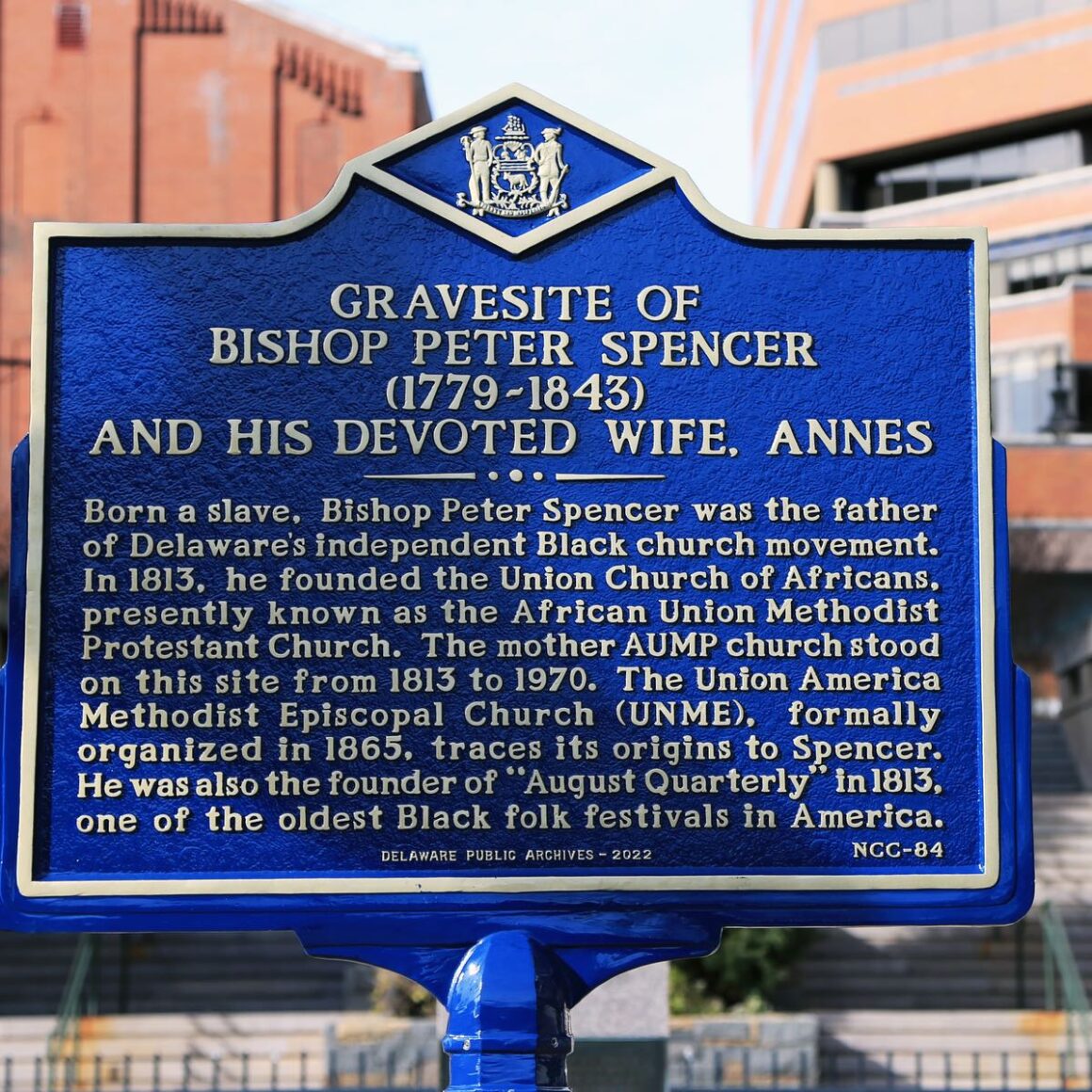Significance: Reverend Peter Spencer is best remembered as the founder of the first fully-independent Black church denomination in the country in 1813. He and his fellow trustees accomplished this in Wilmington Delaware, where the Plaza bearing his name is located. From this institution, initially called the Union Church of African Members, Spencer and the congregants promoted Methodist traditions, education, family life and abolition. The church was known to raise funds to help with fines and legal fees of enslaved people apprehended on the Delaware portion of the Underground Railroad and may have done more than that. Spencer worked closely with Quaker Underground Railroad stationmaster, Thomas Garrett. The plaza features a crypt containing the remains of Spencer, his wife, Annes and several others, and the commemorative sculpture, “Father and Son,” by Charles Cropper Parks.
[MORE]
Peter Spencer was born enslaved in Kent County, Maryland in 1792. According to census records, he was a laborer and mechanic. Upon the death of his enslaver, he was manumitted and relocated to Wilmington, Delaware where he joined a substantial free Black community. Throughout his life, Spencer gained the respect of African Americans and European Americans as he emphasized education and strong family life. While he was a member of Asbury Methodist Episcopal Church, the first Methodist Church built in Wilmington (and which still stands near Third and Walnut Streets), he was inspired to preach, as was his friend, William Anderson, who would also become an important figure in the future of Black Methodism.
Spencer and other Black members quickly tired of the discriminatory practices of the controlling white church at Asbury. Black preachers were not allowed to speak from the pulpit. Black congregants were confined to the balcony section during Sunday service, and only allowed to use the main sanctuary during small meetings, called “class meetings,” where they were given the opportunity to share the joys and sorrows of their spiritual journeys. Upon the accusation that the Black members did not clean up after their meetings, even this puny liberty was rescinded. Determined to control their own worship style, Spencer, Anderson and 40 members of Asbury formed Ezion Methodist Episcopal Church in 1805 at 846 North French Street with property assistance from white Quaker Thomas Gilpin. This action marked the beginning of French Street and environs as an enclave of Black homes, businesses and cultural institutions that lasted through the upheaval of the “Urban Renewal” actions of late 1960s.
The congregation’s experience at Ezion, which remained under the sponsorship of the white-controlled Methodist Episcopal Church, was not satisfactory for long and a contingent left this church with Reverend Spencer to establish the first fully-independent Black denomination in the country in 1813. Thomas Garrett assisted them with procuring land for the sanctuary across French Street from Ezion Church. The church was variously known as Union Church of African Members, African Union Church, and African Union Methodist Church following the renunciation of the “Episcopal” label.
Spencer’s belief that African Americans needed to have a sense of belonging led him to establish an annual religious revival gathering in Wilmington in 1814. It later became known as Big Quarterly/ August Quarterly and has been held continuously to the early 21st century. Initially a religious festival, it grew to include other cultural aspects of Black life. The celebration may have been inspired by the yearly meetings held by Methodists and Quakers to “assess the past, quicken spiritual life in the present, and lay plans for the future.” This last goal played out prior to the Civil War when enslaved persons, with travel passes granted them by their enslavers, attended Big Quarterly and connected with people who were uniquely qualified to help them plan their bid for freedom.
Reverend Spencer died in 1843 at the age of 61 and was eulogized by the entire community as a charismatic leader, educator, organizer and astute businessman. In his lifetime he organized 31 churches in the region, nearly all of them with schools. Disagreements within Union Church came to a head in the 1850s and a split occurred, resulting in the formation of the Union American Methodist Episcopal Church. It was built about 3 blocks to the north on French Street, giving this Black enclave three standing churches associated with Reverend Spencer in the space of 4 blocks.
In 1971, Union Church, then referred to as the Mother African Union Church, relinquished the site under pressure from Wilmington’s federal Urban Renewal program for the construction of the Government Center. Part of the property adjacent to the federal building was set aside for a memorial park to the Spencer legacy. The park features an elevated crypt which contains the remains of Reverend Spencer, his wife, Annes, and an unknown number of others, likely church founders. The sculpture, “Father and Son” by Charles Cropper Parks, honors Spencer’s teachings about strong and loving family life.
References
- Lewis V. Baldwin, The Mark of a Man: Peter Spencer and the African Union Methodist Tradition, The Man, The Movement, The Message and the Legacy (Lanham, Maryland: University Press of America, 1987).
- Peter T. Dalleo, Researching the Underground Railroad in Delaware: A Select Descriptive Bibliography of African American Fugitive Narratives (Wilmington, Delaware: The Underground Railroad Coalition of Delaware and the City of Wilmington, 2008).
- Peter T. Dalleo, “The Growth of Delaware’s Antebellum Free African American Community” (ts, University of Delaware, 1997). https://www1.udel.edu/BlackHistory/antebellum.html
- William H. Williams, Slavery and Freedom in Delaware, 1639-1865 (Wilmington, Delaware: SR Books, 1996).
- Frank R. Zebley, The Churches of Delaware (Wilmington, Delaware, 1947).


